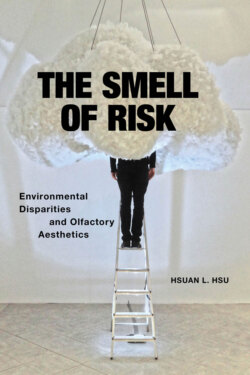The Smell of Risk

Реклама. ООО «ЛитРес», ИНН: 7719571260.
Оглавление
Hsuan L. Hsu. The Smell of Risk
The Smell of Risk. Environmental Disparities and Olfactory Aesthetics
Contents
Introduction. Deodorization and Its Discontents
The Atmospheric Turn
Differential Deodorization
The Perfumed Handkerchief
Olfactory Ecocriticism
1 “Every Crime Has Its Peculiar Odor” Detection, Deodorization, and Intoxication
Detective Fiction and Deodorization
Environmental Detection
Hyperosmia and Risk in MCS Narratives
2. Naturalist Smellscapes and Environmental Justice
Vandover’s Smellscapes
Atmo-terrorism in Environmental Justice Literature
3. Olfactory Art and Museum Ecologies
Conservation Environments
A Trans-corporeal Medium
Olfactory Art and Environmental Risk
4. Atmo-Orientalism. Olfactory Racialization and Environmental Health
Yellow Miasmas
Edith Maude Eaton / Sui Sin Far’s Deodorization Narratives
Atmospheric Conviviality
5. Decolonizing Smell
Colonial Smellscapes
“Air-Conditioned Coffins”
The Smell of Sovereignty
Decolonial Air Conditioning
Epilogue. Reshaping Olfactory Ecologies
Acknowledgments
Notes. Introduction
Chapter 1. “Every Crime Has Its Peculiar Odor”
Chapter 2. Naturalist Smellscapes and Environmental Justice
Chapter 3. Olfactory Art and Museum Ecologies
Chapter 4. Atmo-Orientalism
Chapter 5. Decolonizing Smell
Epilogue
Index
About the Author
Отрывок из книги
Hsuan L. Hsu
NEW YORK UNIVERSITY PRESS
.....
If philosophers and critics have had relatively little to say about the aesthetics of smell, marketing experts have long known that olfactory air conditioning can enhance the appeal of French fries, new car interiors, casinos, and even beer-scented darts.57 As a recent Harvard Business Review article notes, “Scented environments have been shown to reduce typos made by office workers; improve the perception of product quality; increase purchase intent, average unit sales, and duration of a retail visit or stay among consumers; and boost the willingness of consumers to pay more for a product.”58 Research on the chemical senses has been dominated by corporate interests and the search for new markets: in a discussion that pertains to both flavor and scent research, Sarah Tracy writes, “The molecularization of taste and smell extends expert understanding of chemosensation throughout the body, such that the eater’s body-mind is more accessible to the goals of corporate capital.”59 In addition to olfactory marketers, mood enhancement therapists, crowd control weapon manufacturers, memory researchers, and activists wielding stink bombs have found diverse applications for olfaction.
Precisely because it’s so seldom the object of sustained attention, smell is a powerful medium for orienting and communicating our affective predispositions: in her influential theorization of the atmospheric transmission of affect, Teresa Brennan writes that “[the] process whereby one person’s or one group’s nervous and hormonal systems are brought into alignment with another’s . . . works mainly by smell; that is to say, unconscious olfaction.”60 Thus, affect is communicated not only when “[people] observe each other but also because they imbibe each other via smell.”61 Psychologist Silvan Tomkins coined the term “dissmell” to identify an innate affect modeled on the way in which humans register and communicate a defensive response to a noxious odor: “the upper lip and nose are raised and the head is drawn away from the apparent source of the offending odor.”62 Geographers and environmental studies scholars have also noted the importance of smell as both an integral affective component of the sense of place and a tool for detecting invisible environmental changes—including potential threats. In theorizing the concept of “smellscape,” geographer J. Douglas Porteous draws attention to the immersive and emotive force of smell as a dimension of spatial experience.63 Insofar as it attunes us to spatial distinctiveness, olfaction is also particularly well equipped for the task of sensing—and orienting our visceral responses to—geographic disparities.
.....